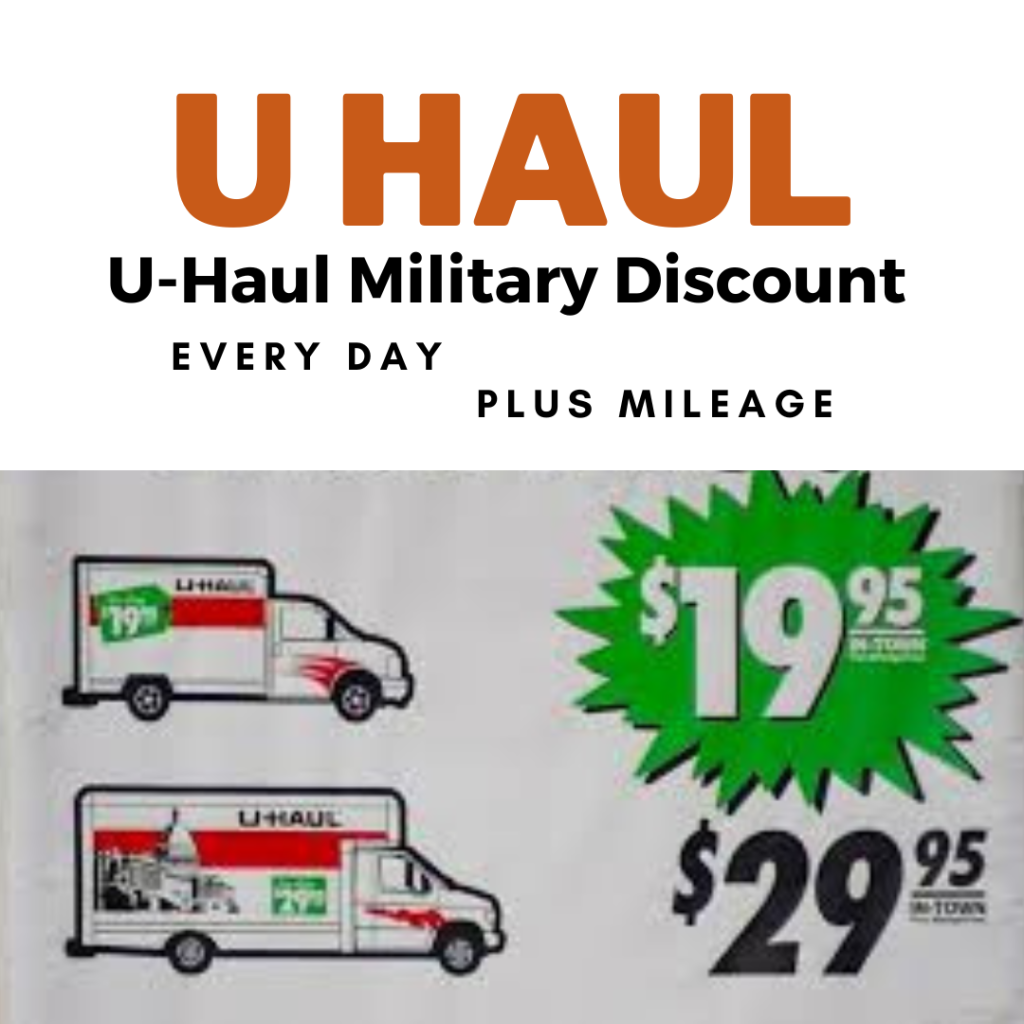U-Haul Truck Discount: Navigating Your Way to Affordable Moving sale.truckstrend.com
Moving is often cited as one of life’s most stressful events, and a significant portion of that stress often stems from the financial burden it entails. From packing supplies to professional movers, the costs can quickly add up, making any opportunity to save money highly valuable. This is where the concept of a "U-Haul Truck Discount" becomes incredibly relevant.
However, it’s crucial to understand that "U-Haul Truck Discount" isn’t a single, fixed discount code you can always apply. Instead, it represents a multifaceted approach to minimizing the overall cost of your U-Haul truck rental. It encompasses a range of strategies, smart planning, and an understanding of U-Haul’s pricing model to ensure you get the best possible value for your move. This comprehensive guide will delve deep into how you can effectively secure these savings, transforming a potentially costly endeavor into a more manageable one.
U-Haul Truck Discount: Navigating Your Way to Affordable Moving
Understanding the U-Haul Pricing Model: The Foundation of Savings
Before we can explore discounts, it’s essential to grasp how U-Haul calculates its rental costs. Unlike a flat fee, U-Haul’s pricing is dynamic and comprises several components:
- Base Rental Rate: This is the initial cost for the truck itself, typically quoted as a daily rate for in-town rentals (e.g., $19.95, $29.95, etc.) or a flat rate for one-way rentals based on the origin, destination, and truck size. This rate can vary significantly based on demand, location, and time of year.
- Mileage Charge: For in-town rentals, you’re charged per mile driven (e.g., $0.69 – $1.09 per mile). One-way rentals usually include a set number of miles in their flat rate, with an additional charge for exceeding that limit.
- Environmental Fee: A small, non-negotiable fee added to most rentals to cover environmental initiatives.
- Taxes: Standard state and local taxes apply to the rental cost.
- Fuel: You are responsible for fueling the truck. U-Haul trucks are typically rented with a specific fuel level (e.g., full or ¼ tank) and must be returned with the same amount, or you’ll incur a refueling charge plus the cost of the missing fuel.
- Optional Add-ons: This is where costs can quickly escalate. These include:
- Supplemental Insurance: Various coverage plans like Safemove®, Safemove Plus®, or Safetrip®.
- Moving Supplies: Boxes, tape, packing paper, bubble wrap, etc.
- Moving Equipment: Dollies (utility, appliance), furniture pads, hand trucks.
- Towing Equipment: Car trailers, auto transports, tow dollies.
- Moving Help®: Labor services for loading and unloading.


Understanding these components is the first step toward identifying areas where you can apply "discounts" or, more accurately, cost-saving strategies.

Unlocking Savings: Types of U-Haul Truck Discounts and Strategies
While U-Haul doesn’t widely advertise fixed percentage discounts like many retailers, there are numerous practical ways to reduce your overall moving expenses. These strategies leverage U-Haul’s operational model and your flexibility as a customer.
1. Strategic Booking and Timing
- Book Early: This is perhaps the most significant "discount" strategy. U-Haul’s pricing is highly dynamic, similar to airline tickets. Booking weeks or even months in advance, especially for one-way rentals, often secures a lower base rate and better availability of your desired truck size. Prices tend to surge closer to the moving date, particularly during peak season.
- Opt for Off-Peak Seasons: Summer (May to August) and the end of each month are U-Haul’s busiest times due to leases ending and school breaks. Moving during the off-season (fall and winter, excluding holidays) or mid-month can result in significantly lower rates.
- Choose Mid-Week Rentals: Weekends are premium rental days. Renting on a Tuesday, Wednesday, or Thursday often comes with a lower base rate compared to Friday, Saturday, or Sunday. If your schedule allows, this flexibility can yield noticeable savings.
- Consider One-Way vs. In-Town Optimization:
- In-Town Rentals: Generally cheaper per day for local moves, but you pay per mile. Best for short distances where you can make multiple trips.
- One-Way Rentals: Have a flat rate that includes a set mileage allowance. This rate is determined by U-Haul’s internal supply and demand for trucks at the origin and destination. Sometimes, U-Haul offers incentives (lower rates) to move trucks to areas where they are needed, making one-way surprisingly affordable for certain routes. Always compare both options, even for seemingly local long-distance moves.
2. Direct Promotional Codes and Coupons
While rare for blanket discounts, U-Haul occasionally releases promotional codes or coupons.
- U-Haul Website/Email List: Sign up for U-Haul’s email newsletter. They sometimes send out special offers or notify subscribers of promotions. Check their official website for any banner ads or dedicated "Deals" sections.
- Third-Party Coupon Sites: Websites like RetailMeNot, Coupons.com, or Groupon sometimes list U-Haul promotions. Always verify the validity and terms of these codes on the U-Haul website before relying on them.
- Partnerships: Occasionally, U-Haul might partner with specific organizations or universities for limited-time offers. It’s worth checking if your employer, university, or affiliated groups have any special arrangements.
3. Smart Management of Optional Costs
This is where you have the most direct control over your spending.
- Decline Unnecessary Insurance: While U-Haul’s supplemental insurance (Safemove, Safemove Plus) offers peace of mind, check your existing auto insurance policy or credit card benefits. Many personal auto policies extend coverage to rental trucks, or certain credit cards offer rental car insurance as a perk. Always confirm coverage specifically for rental trucks (which are often excluded from standard rental car policies) and understand your deductible before declining U-Haul’s coverage.
- Source Moving Supplies Elsewhere: U-Haul sells a full range of moving supplies, but you can often find boxes for free (local grocery stores, liquor stores, Craigslist, Facebook Marketplace) or at lower prices from home improvement stores, online retailers, or even local recycling centers. This can significantly reduce costs.
- Bring Your Own Moving Equipment: If you own a dolly or furniture pads, use them. Renting these items from U-Haul adds to the cost.
- DIY Moving Help: U-Haul’s Moving Help® service connects you with local laborers. While convenient, recruiting friends and family to help you load and unload can save hundreds of dollars in labor costs. Offer to provide food and drinks as a thank you.
4. Fuel Efficiency and Mileage Optimization
Fuel is a major, often underestimated, expense.
- Choose the Right Truck Size: Renting a truck that’s too small means multiple trips, increasing mileage and fuel consumption. Renting one that’s too large means higher base rates and poorer fuel economy. Use U-Haul’s online estimators or consult with a representative to pick the ideal size for your belongings.
- Plan Your Route Carefully: Use GPS to find the most direct and efficient route, avoiding heavy traffic, steep hills (which consume more fuel), and unnecessary detours.
- Drive Conservatively: Avoid rapid acceleration, hard braking, and excessive speeds. Driving at a consistent, moderate speed (often around 55-65 mph, depending on the truck and road) is the most fuel-efficient.
- Return with the Correct Fuel Level: Pay attention to the fuel level when you pick up the truck and return it with the same amount to avoid hefty refueling charges from U-Haul.
5. Leveraging U-Haul’s Operational Nuances
- Check Multiple Locations: Prices for the same truck size can vary between different U-Haul centers or authorized dealers within the same city, depending on their individual inventory and demand. It pays to check a few nearby locations.
- Consider a Smaller Truck with a Trailer: For some moves, renting a smaller truck and attaching a U-Haul cargo or utility trailer might be cheaper than renting a larger truck, especially if you have bulky items that don’t fit in a smaller truck but don’t warrant a massive vehicle.
- Return On Time and Clean: Avoid late fees by returning the truck by the agreed-upon time. Also, ensure the truck is reasonably clean to avoid cleaning fees. A quick sweep out of debris is usually sufficient.
How to Secure Your U-Haul Truck Discount: A Step-by-Step Guide
-
Assess Your Needs Accurately:
- Inventory: Make a detailed list of all items you’re moving.
- Distance: Is it an in-town move or a long-distance one-way trip?
- Timeline: How flexible are your moving dates?
- Assistance: Do you need help loading/unloading?
-
Use U-Haul’s Online Tools:
- Go to U-Haul’s official website (uhaul.com).
- Enter your pickup location, drop-off location (if one-way), and desired dates.
- Browse the available truck sizes and their initial estimated costs. This is where you can compare prices for different dates and times.
-
Compare and Adjust:
- Flexibility is Key: If your dates are flexible, try entering different pickup and return dates (mid-week vs. weekend, mid-month vs. end-of-month) to see how the base rate changes.
- Location Scout: Input different nearby pickup locations to see if prices vary.
- One-Way vs. In-Town: If you’re on the cusp of a long local move, compare the one-way rate to the in-town rate plus estimated mileage.
-
Apply Promo Codes (If Applicable):
- During the online reservation process, there’s usually a field for "Promotional Code" or "Coupon Code." Enter any valid codes you’ve found.
-
Review and Customize Optional Add-ons:
- As you proceed, U-Haul will offer insurance, dollies, blankets, and other items. Carefully review each one.
- Decline what you don’t need or already have covered. For example, if your personal auto insurance covers rental trucks, uncheck the insurance options.
- Consider Bundles: Sometimes, U-Haul offers small discounts if you bundle a truck with storage or specific moving supplies. Evaluate if these truly save you money compared to sourcing items independently.
-
Confirm and Re-confirm:
- Before finalizing, review the entire estimated cost breakdown, including all fees, taxes, and any applied discounts.
- Pay attention to the fuel level requirement for return.
- Save your reservation confirmation.
Important Considerations and Potential Challenges
- Availability: The biggest challenge to securing discounts is often truck availability, especially during peak season. Booking early mitigates this.
- Dynamic Pricing: U-Haul’s pricing algorithms constantly adjust based on supply and demand. What’s cheap today might be expensive tomorrow.
- Hidden Fees (Avoidable): While U-Haul is transparent about its fees, costs can creep up if you’re not careful:
- Late Return Fees: Return the truck on time.
- Refueling Charges: Return with the correct fuel level.
- Cleaning Fees: Return the truck reasonably clean.
- Mileage Overages: For one-way rentals, stay within your allotted miles.
- Insurance Coverage Gaps: Don’t assume your personal insurance covers everything. Verify rental truck coverage specifically, including cargo and liability. The "discount" of not taking U-Haul’s insurance could turn into a massive expense if an accident occurs.
- Truck Size vs. Cost: Don’t automatically go for the smallest truck to save money if it means multiple trips or a potential second rental. Accurately estimating your needs is key.
Table of U-Haul Cost Components and Savings Strategies
As U-Haul’s pricing is highly dynamic and discounts aren’t fixed percentages, this table illustrates typical cost components and how various strategies can lead to savings, rather than fixed "discount" amounts.
| Cost Component | Typical Cost Range (Example) | Common Saving Strategy | Potential Savings Impact |
|---|---|---|---|
| Base Rental Rate | $19.95 – $99.95/day (In-Town); $100s – $1000s (One-Way) | Book early, rent mid-week/mid-month, off-peak season | Significant (10-30% or more on base rate, depending on demand) |
| Mileage Charge | $0.69 – $1.09/mile | Plan efficient route, choose right truck size | Varies (Reduces miles driven, preventing overage charges on one-way) |
| Fuel | Varies (Based on current gas prices, truck size) | Drive efficiently, return with correct fuel level | Significant (Avoid U-Haul’s refueling markup, reduce overall fuel consumption) |
| Supplemental Insurance | $14 – $50+/day | Decline if covered by personal auto/credit card insurance | Up to 100% of insurance cost (if already covered) |
| Moving Supplies | Varies (Boxes, tape, etc.) | Source free/cheaper supplies elsewhere, re-use | Significant (10-50% on supply costs, depending on items) |
| Moving Equipment | $7 – $25+/item/day | Use your own, borrow from friends, consider needs | Up to 100% of equipment rental cost |
| Moving Help® (Labor) | $150 – $600+ (2 hrs, 2 movers) | Recruit friends/family, DIY loading/unloading | Up to 100% of labor costs |
| Towing Equipment | $40 – $150+/day | Drive second vehicle, sell car before move | Varies (Avoid rental if alternative transport is possible) |
| Late Return Fees | Varies (Daily rate + penalties) | Return on time | 100% of late fees |
| Cleaning Fees | $25 – $50+ | Return truck reasonably clean | 100% of cleaning fees |
Frequently Asked Questions (FAQ) About U-Haul Truck Discounts
Q1: Does U-Haul offer specific military discounts?
A1: U-Haul does not have a standing, publicly advertised military discount program. However, they occasionally run special promotions that may benefit military personnel. It’s always worth checking their website or asking directly when reserving, as local dealers might have discretion or specific offers.
Q2: Are there U-Haul student discounts available?
A2: Similar to military discounts, U-Haul does not typically offer a universal student discount. Some universities or student organizations might have specific partnerships or promotional codes for their students, so it’s best to check with your institution’s housing or student services department.
Q3: Can I use my AAA or AARP membership for a U-Haul discount?
A3: Generally, U-Haul does not offer discounts through AAA or AARP memberships. These programs are more commonly associated with car rental agencies, hotels, or roadside assistance.
Q4: Where can I reliably find U-Haul promo codes?
A4: The most reliable sources are U-Haul’s official website, signing up for their email newsletter, or reputable third-party coupon sites (always double-check validity). Direct, significant promo codes are rare but do pop up during specific promotional periods.
Q5: Is it cheaper to rent a U-Haul one-way or in-town?
A5: It depends entirely on your move. For short, local moves where you can make multiple trips, in-town is usually cheaper (daily rate + mileage). For long-distance moves, one-way is almost always cheaper, as it includes a set mileage allowance and is priced based on demand for trucks at the origin and destination. Always compare both options for your specific route.
Q6: How can I save money on U-Haul mileage?
A6: To save on mileage, plan the most direct route using GPS, avoid unnecessary detours, and choose the right truck size to minimize the number of trips. For one-way rentals, ensure your estimated mileage is within the included allowance to avoid overage fees.
Q7: Should I purchase U-Haul’s supplemental insurance?
A7: This is a personal decision. While it adds to the cost, it offers peace of mind. Check your existing auto insurance policy and credit card benefits to see if they cover rental trucks (many standard policies do not). If you’re not covered, U-Haul’s Safemove® or Safemove Plus® can be a wise investment against potential damage to the truck or cargo.
Q8: What is the cheapest day or time to rent a U-Haul?
A8: The cheapest days are typically mid-week (Tuesday, Wednesday, Thursday) and mid-month. Avoiding the end of the month and peak summer season (May-August) will also generally result in lower rates.
Q9: Does U-Haul price match competitors?
A9: U-Haul generally does not have a formal price-matching policy for competitors. Their pricing is dynamic and competitive within the market, but you won’t typically be able to present a quote from another company for a match.
Q10: How do I avoid hidden fees with U-Haul?
A10: The best way to avoid "hidden" fees is to read your rental agreement carefully. Return the truck on time, with the correct fuel level, and reasonably clean. Understand your mileage allowance for one-way rentals. These are common reasons for unexpected charges.
Conclusion: Smart Moving, Smarter Savings
The journey of moving, while daunting, doesn’t have to break the bank. The concept of a "U-Haul Truck Discount" is less about finding a single magical coupon and more about adopting a strategic, informed approach to your rental. By understanding U-Haul’s pricing model, leveraging flexible booking times, meticulously managing optional costs, and optimizing your fuel and mileage, you can significantly reduce your moving expenses.
The real discount comes from your proactive planning and smart decisions. Every dollar saved on your U-Haul truck rental is a dollar that can be put towards setting up your new home, making your transition smoother and more enjoyable. So, plan wisely, execute smartly, and move confidently, knowing you’ve secured the best possible value for your journey.




